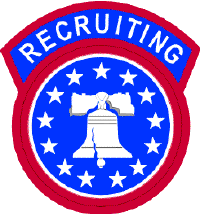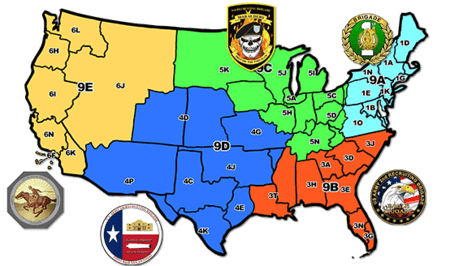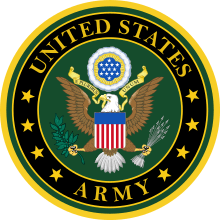United States Army Recruiting Command
The United States Army Recruiting Command (USAREC) mission is to "Recruit America's best and brightest volunteers that are able to deploy, fight, and win". This process includes the recruiting, medical and psychological examination, induction, and administrative processing of potential service personnel.
| U.S. Army Recruiting Command (USAREC) | |
|---|---|
 USAREC shoulder sleeve insignia (SSI) | |
| Active | 1822 – present |
| Country | |
| Branch | |
| Role | Army recruiting and accessions |
| Size | Division |
| Part of | United States Army Training and Doctrine Command (TRADOC) |
| Garrison/HQ | Fort Knox, Kentucky |
| Commanders | |
| Commander | Major General Kevin Vereen |
| Insignia | |
| Distinctive unit insignia |  |
The Recruiting Command is a field operating agency administratively responsible to the Office of the Deputy Chief of Staff for Personnel. The Command employs more than 7200 Active and Reserve Component recruiters at more than 1,600 recruiting centers across the United States and overseas.[1] The Command is guided in its operations by the United States Mobilization Doctrine.[2]
The Command is commanded by a Major General, and assisted by a Deputy Commanding General (Brigadier General), with five recruitment brigades and a number of support brigades in the Command.[3]
U.S. Army recruiters generally are DA selected for three-year assignments. These "detailed" recruiters return to their primary military occupational specialty after obligation as recruiters. Station Commanders and reserve recruiters are all career recruiters who stay within USAREC for the duration of their careers.
General Paul Gorman's (USA, ret.) in his institutional history of the U.S. Army, The Secret of Future Victories, credits George C. Marshall as the architect of the modern version of the current system for personnel allocation.[4]
History
Recruiting for the U.S. Army began in 1775 with the raising and training of the Continentals to fight in the American Revolutionary War under Article I of the U.S. Constitution. The Command traces its organisational history to 1822, when Major General Jacob Jennings Brown, commanding general of the Army, initiated the General Recruiting Service.[5] For much of the rest of the 19th century recruitment was left to the regimental recruiting parties, usually recruiting in their regional areas as was the practice in Europe.
Up to the commencement of the American Civil War two types of forces existed in the United States that performed their own recruiting: those for the regular Federal service, and those for the state Militia service.
Due to severe shortage of troops after the first year of the war, conscription was introduced by both the Union and the Confederacy to enable continuing of operations on a thousand-mile front. The conscription was first introduced in the South by President Jefferson Davis on the recommendation by General Robert E. Lee on 16 April 1862. The U.S. Congress enacted by comfortable majorities the Enrollment Act of 1863, also known as the Conscription Act, on 3 March after two weeks of debate.[6] As a result, approximately 2,670,000 men were conscripted for federal and militia service by the Northern states.
The realization that volunteers could never again be depended on for service was clear in the post-war analysis, but the dependence on them prevailed until the commencement of the First World War when President Woodrow Wilson, arguing for America's exclusion from the European war, believed that there would be found sufficient volunteers to meet the nation's military needs.[7] However, European experiences with industrial warfare prevailed, and two years later the US Congress passed the Selective Service Act of 1917.[8] There were two primary reasons for President Wilson approving conscription: he recognized the efficiency and equity of the draft over the difficult-to-manage system of inducting and training volunteers, and that by opting for conscription, he realized the possibility of blocking one of his leading political critics and opponents, former President Theodore Roosevelt from raising a volunteer force to lead in France.[9] The Act was however very selective in that "the draft ‘selected’ those men the Army wanted and society could best spare: 90 percent of the draftees were unmarried, and 70 percent were farm hands or manual hands."[10]
Conscription was again used to create a war-time Army from a small peace-time professional cadre in 1941, which eventually numbered 8.3 million personnel. However, there was a society-wide support for the conscription during the Second World War, in part due to efforts of the National Emergency Committee (NEC) of the Military Training Corps Association led by Greenville Clark who became known as the "Father of Selective Service." The Congress, faced with imminent need to mobilize, still took three months of debate until finally passing the Selective Training and Service Act (STASA) of 1940 in June. Nearly 50 million men registered and 10 million were inducted into armed forces under the Act.
Although the STASA was extended after the war, it ended on 31 March 1947, and the Army had to turn to recruiting volunteers again, requiring and estimated 30,000 volunteers a month, but seeing only 12,000 enlisting.[11]
With the Cold War looming, the Congress authorized the Selective Service Act of 1948 to enable President Truman to provide for 21 months of active Federal service, with all men from ages 18 to 26 required to register. This Act was extended due to the start of the Korean War, and replaced by the Universal Military Training and Service Act of 1951 by revising the earlier Act.
The new Act extended the president’s authority to induct citizens for four years, granted him the authority to recall reservists, lowered the draft age to 18, lengthened the term of service to two years, and cancelled deferments for married men without children.[11]
With the end of the Korean War, the draft remained in force, but became increasingly unpopular although it continued to encourage volunteers and selected the bare minimum of annual recruits. Repeatedly renewed by overall majorities in Congress in 1955, 1959, and 1963, its final extension in 1967 was also passed by a majority of Congress, but only after a year of hearings and public debate. The U.S. Army became an all-volunteer force again in 1973. During the years of the Vietnam War between From 1965 to 1973, there were 1,728,254 inductions through selective service.[12] There was however a direct effect on public support for the draft that was high even after the Korean War to its low in early 1970s because
Draftees, who constituted only 16 percent of the armed forces, but 88 percent of infantry soldiers in Vietnam, accounted for over 50 percent of combat deaths in 1969, a peak year for casualties. Little wonder that the draft became the focus of anti-Vietnam activism.[13]
With these political consequences in mind in 1969 President Nixon appointed a commission, led by former Secretary of Defense Thomas Gates, "to develop a comprehensive plan for eliminating conscription and moving toward an All Volunteer Armed Force." However, even before this commission submitted its report on 13 May 1969, President Nixon informed the Congress that he intended to institute a reform that would see the draftees replaced with volunteers in his Special Message to Congress on Reforming the Military Draft. In February 1970, the Gates Commission released its favorable AVF report, which stated that
"We unanimously believe that the nation’s interests will be better served by an all-volunteer force, supported by an effective stand-by draft, than by a mixed force of volunteers and conscripts; that steps should be taken promptly to move in this direction."[14]
Facilitating the transition to an all-volunteer force, the Army created District Recruiting Commands (DRC) through the continental United States to direct the efforts of its recruiters among the civilian population. The DRC's became "Battalions" in 1983.
Recruiting brigades

USAREC consists of eight brigades: five enlisted recruiting, one medical recruiting, and two recruiting support brigades. Each enlisted and medical recruiting brigade consists of a number of battalions, with each battalion consisting of four to seven companies. Each battalion is commanded by a Lieutenant Colonel, and employees about 12 officers, 20 civilian support staff, and 250 enlisted Soldiers, the majority of whom work as on-production recruiters performing the bulk of USAREC's mission of providing recruiting support at offices throughout the United States, Puerto Rico, the U.S. Virgin Islands, Guam, American Samoa, and at U.S. military facilities in Europe, Japan, and South Korea.
The recruiting brigades and their battalions, are:[15]
- U.S. Army 1st Recruiting Brigade, located at Fort George G. Meade, Maryland. This brigade covers the Northeastern United States, as well as all European-based Army recruiting offices.[16]
- 1A U.S. Army Recruiting Battalion Albany, Watervliet, New York[17]
- 1B U.S. Army Recruiting Battalion Baltimore, Fort George G. Meade, Maryland[18]
- 1D U.S. Army Recruiting Battalion New England, Portsmouth, New Hampshire[19]
- 1E U.S. Army Recruiting Battalion Harrisburg, New Cumberland Army Depot, PA[20]
- 1G U.S. Army Recruiting Battalion New York City, Fort Hamilton, New York[21]
- 1K U.S. Army Recruiting Battalion Mid-Atlantic, Lakehurst Naval Air Station, New Jersey[22]
- 1N U.S. Army Recruiting Battalion Syracuse, Syracuse, New York[23]
- 1O U.S. Army Recruiting Battalion Richmond, Richmond, Virginia[24]
- U.S. Army 2d Recruiting Brigade, located at Redstone Arsenal, Alabama. This brigade covers the Southeastern United States, Puerto Rico, and the U.S. Virgin Islands.[25]
- 3A U.S. Army Recruiting Battalion Atlanta, Smyrna, Georgia[26]
- 3D U.S. Army Recruiting Battalion Columbia, Columbia, South Carolina[27]
- 3E U.S. Army Recruiting Battalion Jacksonville, Jacksonville, Florida[28]
- 3G U.S. Army Recruiting Battalion Miami, Florida[29]
- 3H U.S. Army Recruiting Battalion Maxwell Air Force Base, Alabama[30]
- 3J U.S. Army Recruiting Battalion Raleigh, North Carolina[31]
- 3N U.S. Army Recruiting Battalion Tampa, Tampa, Florida[32]
- 3T U.S. Army Recruiting Battalion Baton Rouge, Baton Rouge, Louisiana[33]
- U.S. Army 3d Recruiting Brigade, located at Fort Knox, Kentucky. This brigade covers part of the Midwest United States[34]
- 5A U.S. Army Recruiting Battalion Chicago, Great Lakes, Illinois[35]
- 5C U.S. Army Recruiting Battalion Cleveland, Cleveland, Ohio[36]
- 5D U.S. Army Recruiting Battalion Columbus, Columbus, Ohio[37]
- 5H U.S. Army Recruiting Battalion Indianapolis, Indianapolis, Indiana[38]
- 5I U.S. Army Recruiting Battalion Great Lakes, Lansing, Michigan[39]
- 5J U.S. Army Recruiting Battalion Milwaukee, Milwaukee, Wisconsin[40]
- 5K U.S. Army Recruiting Battalion Minneapolis, Fort Snelling, Minnesota[41]
- 5N U.S. Army Recruiting Battalion Nashville, Nashville, Tennessee[42]
- U.S Army 5th Recruiting Brigade, located at Fort Sam Houston, Texas. This brigade covers the Southwestern United States, along with part of the Midwest not covered by the 3d Recruiting Brigade.[43]
- 4C U.S. Army Recruiting Battalion Dallas, Irving, Texas[44]
- 4D U.S. Army Recruiting Battalion Denver, Denver, Colorado[45]
- 4E U.S. Army Recruiting Battalion Houston, Houston, Texas[46]
- 4G U.S. Army Recruiting Battalion Kansas City, Kansas City, Missouri[47]
- 4J U.S. Army Recruiting Battalion Oklahoma City, Oklahoma City, Oklahoma[48]
- 4K U.S. Army Recruiting Battalion San Antonio, Fort Sam Houston, Texas[49]
- 4P U.S. Army Recruiting Battalion Phoenix, Phoenix, Arizona[50]
- U.S. Army 6th Recruiting Brigade, located at Nellis Air Force Base, Nevada. This brigade covers the Western United States, along with Alaska, Hawaii, Guam, American Samoa, and offices based in Japan and South Korea. [51]
- 6F U.S. Army Recruiting Battalion Los Angeles, Encino, California[52]
- 6H U.S. Army Recruiting Battalion Portland, Portland, Oregon[53]
- 6I U.S. Army Recruiting Battalion Northern California, Rancho Cordova, California[54]
- 6J U.S. Army Recruiting Battalion Salt Lake City, Salt Lake City, Utah[55]
- 6K U.S. Army Recruiting Battalion Southern California, Mission Viejo, California[56]
- 6L U.S. Army Recruiting Battalion Seattle, Seattle, Washington[57]
- 6N U.S. Army Recruiting Battalion Central California, Fresno, California[58]
- U.S. Army Medical Recruiting Brigade, located at Fort Knox, Kentucky. This brigade covers the entire United States and recruits medical professionals and chaplains to serve as commissioned officers in the Army Medical Department or Army Chaplain Corps. The brigade also provides operational oversight for all in-service recruiting efforts for the Army's special operations forces.[59]
- 9A 1st Medical Recruiting Battalion Fort Meade, Maryland[60]
- 9B 2nd Medical Recruiting Battalion Redstone Arsenal, Alabama[61]
- 9C 3rd Medical Recruiting Battalion Fort Knox, Kentucky[62]
- 9D 5th Medical Recruiting Battalion Fort Sam Houston, Texas[63]
- 9E 6th Medical Recruiting Battalion Las Vegas, Nevada[64]
- 9X Special Operations Recruiting Battalion, Fort Bragg, North Carolina[65]
- 9Z Chaplain Recruiting Branch, Fort Knox, Kentucky[66]
- U.S. Army Marketing and Engagement Brigade, located at Fort Knox, Kentucky. This brigade provides recruiting support to the enlisted and medical recruiting brigades by operating exhibit vehicles, setting up displays, and providing demonstrations of Army personnel and equipment.[67]
- U.S. Army Mission Support Battalion, Fort Knox, Kentucky[68]
- U.S. Army Parachute Team, Fort Bragg, North Carolina
- U.S. Army Marksmanship Unit, Fort Benning, Georgia
- U.S. Army Recruiting and Retention College, located at Fort Knox, Kentucky, is responsible for the training of all Army and Army Reserve recruiters and career counselors, as well as advanced training on recruiting office leadership and higher-level management. Soldiers selected for duty as a recruiter, career counselor, or recruiting unit leader must graduate from here before being assigned to a recruiting brigade or battalion.
Command
Current key command personnel of the Command include:[69]
- Commanding General - Major General Kevin Vereen
- Deputy Commanding General (Support) Vacant
- Deputy Commanding Officer (Operations) - Brigadier General Patrick Michaelis
- Command Sgt. Maj. John W. Foley
Past commanders
- Major General Kevin Vereen 2020–Present
- Major General Frank M. Muth 2018 - 2020
- Major General Jeffrey J. Snow 2015 - 2018
- Major General Allen W. Batschelet 2013 - 2015
- Major General David L. Mann 2011 - 2013
- Major General Donald M. Campbell Jr. 2009 - 2011
- Major General Thomas P. Bostick 2005 - 2009
- Major General Michael D. Rochelle 2002 – 2005
- Major General Dennis D. Cavin 2000 - 2002
- Major General Evan R. Gaddis 1998 - 2002
- Major General Mark R. Hamilton 1997 - 1998
- Major General Alfonso E. Lenhardt 1996 - 1997
- Major General Kenneth W. Simpson 1993 - 1996
- Major General Jack C. Wheeler 1989 - 1993
- Major General Thomas P. Carney 1987 -1989
- Major General Allen K. Ono 1985 - 1987
- Major General Jack O. Bradshaw 1983 - 1985
- Major General Howard G. Crowell Jr. 1981 - 1983
- Major General Maxwell R. Thurman 1979 – 1981
- Major General William L. Mundie 1978 - 1979
- Major General Eugene P. Forrester 1975 - 1978
- Major General William B. Fulton 1974 - 1975
- Major General John Q. Henion 1971 - 1974
- Brigadier General Carter W. Clarke Jr. 1971
- Major General Donald H. McGovern 1968 - 1971
- Brigadier General Frank L. Gunn 1966 - 1968
- Brigadier General Leonidas Gavalas 1964 - 1966
See also
Initiatives
Comparable organizations
- Marine Corps Recruiting Command (U.S. Marine Corps)
- United States Navy Recruiting Command
- Air Education and Training Command (U.S. Air Force)
Notes and references
- 'Business Wire', U.S. Army Recruiting Command Signs up with Click2learn; Nationwide Implementation of the Aspen Learning Management System Will Reach More Than 7200 Recruiters, Bellevue, Wash., 11 December 2002
- pp.53–54, Vandergriff
- U.S. Army Recruiting Command Brigade and Battalion Public Affairs Offices, March 2009
- p.53, Vandergriff
- pp.54–55, Vandergriff
- p.56, Vandergriff
- "State of the Union Address - Teaching American History". teachingamericanhistory.org.
- pp.57, Vandergriff
- pp.58, Vandergriff
- p.58, Vandergriff
- p.60, Vandergriff
- p.61, Vandergriff
- pp. 23–50, van Creveld
- p.10, Gates
- Map of US Army recruiting brigades and battalions
- "United States Army Recruiting Command (USAREC)". www.usarec.army.mil.
- "United States Army Recruiting Command (USAREC)". www.usarec.army.mil.
- "United States Army Recruiting Command (USAREC)". www.usarec.army.mil.
- "United States Army Recruiting Command (USAREC)". www.usarec.army.mil.
- "United States Army Recruiting Command (USAREC)". www.usarec.army.mil.
- "United States Army Recruiting Command (USAREC)". www.usarec.army.mil.
- "United States Army Recruiting Command (USAREC)". www.usarec.army.mil.
- "United States Army Recruiting Command (USAREC)". www.usarec.army.mil.
- "United States Army Recruiting Command (USAREC)". www.usarec.army.mil.
- "United States Army Recruiting Command (USAREC)". www.usarec.army.mil.
- "Pathfinders".
- "United States Army Recruiting Command (USAREC)". www.usarec.army.mil.
- "United States Army Recruiting Command (USAREC)". www.usarec.army.mil.
- "United States Army Recruiting Command (USAREC)". www.usarec.army.mil.
- "United States Army Recruiting Command (USAREC)". www.usarec.army.mil.
- "United States Army Recruiting Command (USAREC)". www.usarec.army.mil.
- "United States Army Recruiting Command (USAREC)". www.usarec.army.mil.
- "United States Army Recruiting Command (USAREC)". www.usarec.army.mil.
- "United States Army Recruiting Command (USAREC)". www.usarec.army.mil.
- "United States Army Recruiting Command (USAREC)". www.usarec.army.mil.
- "United States Army Recruiting Command (USAREC)". www.usarec.army.mil.
- "United States Army Recruiting Command (USAREC)". www.usarec.army.mil.
- "United States Army Recruiting Command (USAREC)". www.usarec.army.mil.
- "United States Army Recruiting Command (USAREC)". www.usarec.army.mil.
- "United States Army Recruiting Command (USAREC)". www.usarec.army.mil.
- "United States Army Recruiting Command (USAREC)". www.usarec.army.mil.
- "United States Army Recruiting Command (USAREC)". www.usarec.army.mil.
- "United States Army Recruiting Command (USAREC)". www.usarec.army.mil.
- "United States Army Recruiting Command (USAREC)". www.usarec.army.mil.
- "United States Army Recruiting Command (USAREC)". www.usarec.army.mil.
- "United States Army Recruiting Command (USAREC)". www.usarec.army.mil.
- "United States Army Recruiting Command (USAREC)". www.usarec.army.mil.
- "United States Army Recruiting Command (USAREC)". www.usarec.army.mil.
- "United States Army Recruiting Command (USAREC)". www.usarec.army.mil.
- "United States Army Recruiting Command (USAREC)". www.usarec.army.mil.
- "United States Army Recruiting Command (USAREC)". www.usarec.army.mil.
- "United States Army Recruiting Command (USAREC)". www.usarec.army.mil.
- "United States Army Recruiting Command (USAREC)". www.usarec.army.mil.
- "United States Army Recruiting Command (USAREC)". www.usarec.army.mil.
- "United States Army Recruiting Command (USAREC)". www.usarec.army.mil.
- "United States Army Recruiting Command (USAREC)". www.usarec.army.mil.
- "United States Army Recruiting Command (USAREC)". www.usarec.army.mil.
- "United States Army Recruiting Command (USAREC)". www.usarec.army.mil.
- "United States Army Recruiting Command (USAREC)". www.usarec.army.mil.
- "United States Army Recruiting Command (USAREC)". www.usarec.army.mil.
- "United States Army Recruiting Command (USAREC)". www.usarec.army.mil.
- "United States Army Recruiting Command (USAREC)". www.usarec.army.mil.
- "United States Army Recruiting Command (USAREC)". www.usarec.army.mil.
- http://www.bragg.army.mil/sorb/ Special Operations Recruiting Battalion – The Pathfinders
- "Army Chaplain Corps". goarmy.com.
- "redirect". www.usarec.army.mil.
- >
- "Command Group".
Sources
- van Creveld, Martin, The Transformation of War, The Free Press, New York, 1991
- Vandergriff, Donald, Manning the Future Legions of the United States, Praeger Security International, London, 2008
- Gates, Thomas, S., The Report of the President's Commission on an All-Volunteer Armed Force, US Government Printing Office, Washington, DC, 1970
External links
- Brigades and Battalions of the Recruiting Command
- Support Army Recruiting
- United States Army at the Wayback Machine (archived 16 October 1997)
- Official recruiting website
